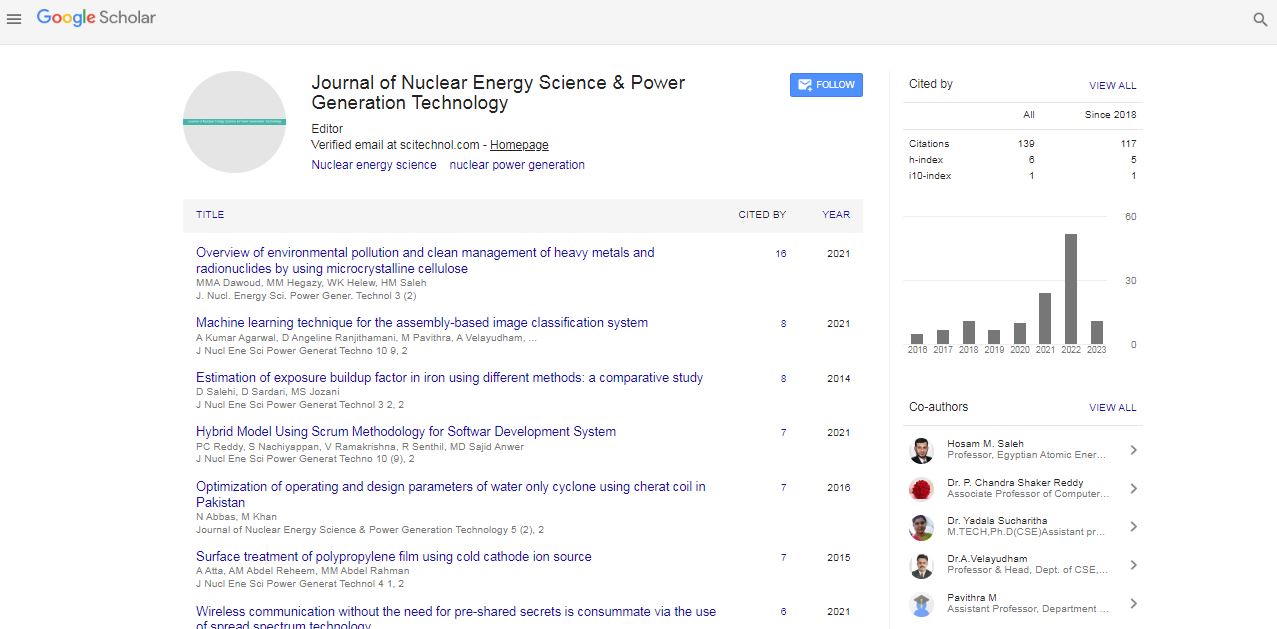Commentary, J Nucl Ene Sci Power Generat Technol Vol: 12 Issue: 1
Applications and Numerical Methods of Computational Fluid Dynamics
Chuan Cheng*
1Department of Mechanical Engineering, Chung Yuan Christian University, Taoyuan, Taiwan
*Corresponding Author: Chuan Cheng
Department of Mechanical Engineering, Chung Yuan Christian University, Taoyuan, Taiwan
E-mail: chuancheng@cycu.edu.tw
Received date: 22-Feb-2023, Manuscript No. JNPGT-23-93181;
Editor assigned date: 24-Feb-2023, PreQC No. JNPGT-23-93181 (PQ);
Reviewed date: 10-Mar-2023, QC No. JNPGT-23-93181;
Revised date: 17-Mar-2023, Manuscript No. JNPGT-23-93181 (R);
Published date: 27-Mar-2023 DOI: 10.4172/2325-9809.1000318.
Citation: Cheng C (2023) Applications and Numerical Methods of Computational Fluid Dynamics. J Nucl Ene Sci Power Generat Technol 12:2.
Description
Computational Fluid Dynamics (CFD) is a branch of fluid mechanics that uses numerical methods and algorithms to solve and analyse fluid flow problems. CFD has become an important tool in many industries, including aerospace, automotive, chemical, civil, and environmental engineering.
CFD is a computer-based simulation technique used to predict fluid flow patterns and behaviors. It uses a set of mathematical equations that describe the behavior of fluids, such as the Navier-Stokes equations, to predict the flow of fluids in a given domain. The equations are discretized and solved numerically using various numerical methods.
Applications of CFD
CFD has numerous applications in various industries. Some of the common applications of CFD include:
Aerodynamics: CFD is used to study the flow of air around airplanes, cars, and other vehicles. It is used to optimize the design of aerodynamic components, such as wings, fins, and spoilers.
Chemical and process engineering: CFD is used to study the behavior of fluids in chemical reactors, distillation columns, and other industrial processes. It is used to optimize the design of these processes and to improve their efficiency.
Environmental engineering: CFD is used to study the flow of water and air in rivers, lakes, and oceans. It is used to study the impact of pollutants on the environment and to develop strategies to mitigate their effects.
Biomedical engineering: CFD is used to study the flow of blood in arteries and veins. It is used to diagnose and treat cardiovascular diseases and to develop new medical devices.
Numerical methods in CFD
CFD uses numerical methods to solve the equations that describe fluid flow. Some of the commonly used numerical methods in CFD are:
Finite Difference Method (FDM): FDM is a numerical method used to solve differential equations. It involves dividing the domain into a grid and approximating the derivatives using finite differences. FDM is simple to implement and is computationally efficient for simple geometries.
Finite Volume Method (FVM): FVM is a numerical method used to solve the conservation equations of fluid mechanics. It involves dividing the domain into control volumes and approximating the fluxes through the control volume faces. FVM is commonly used for complex geometries and unstructured grids.
Finite Element Method (FEM): FEM is a numerical method used to solve partial differential equations. It involves dividing the domain into elements and approximating the solution within each element using a set of basic functions. FEM is commonly used for complex geometries and irregular domains.
CFD software
CFD software packages are used to perform CFD simulations. Some of the commonly used CFD software packages are:
ANSYS fluent: ANSYS fluent is a commercial CFD software package developed by ANSYS Inc. It is widely used in the aerospace, automotive, and energy industries.
Open FOAM: Open FOAM is a free, open-source CFD software package developed by the Open FOAM Foundation. It is widely used in academic research and in the automotive and aerospace industries.
STAR-CCM+: STAR-CCM+ is a commercial CFD software package developed by CD-adapco. It is widely used in the automotive, aerospace, and marine industries.
Conclusion
CFD has become an important tool in many industries, allowing engineers and scientists to simulate fluid flow and analyze its behavior. CFD simulations can provide valuable insights into the behavior of fluids in complex geometries and under varying conditions. The development of powerful numerical methods and CFD software packages has made CFD more accessible to researchers and engineers.
 Spanish
Spanish  Chinese
Chinese  Russian
Russian  German
German  French
French  Japanese
Japanese  Portuguese
Portuguese  Hindi
Hindi 

